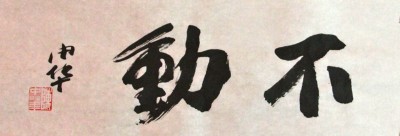Originally written by: Allan Belsheim Nov 2007
When Master Chen Zhonghua shows us how to do the Chen form, he assures us that the hands are NOT moving. To look at him, everything is moving, including the hand. When we copy his moves, we are told that we are moving our hands and on top of that, we are tossing our bodies. The less we seem to move the more we are told that we are moving.
 Master Chen tells us a story about his teacher Hong Junsheng. When Hong was touched, even after he was paralyzed from the waist down, the person touching him was thrown with barely a move on Hong’s part. Hong would be in contact with the attacking person and NOT move, but yet the person was thrown. Master Chen assured us that it wasn’t fakery involved. We wondered how this is possible, so we checked further into the form and especially the “circles”.
Master Chen tells us a story about his teacher Hong Junsheng. When Hong was touched, even after he was paralyzed from the waist down, the person touching him was thrown with barely a move on Hong’s part. Hong would be in contact with the attacking person and NOT move, but yet the person was thrown. Master Chen assured us that it wasn’t fakery involved. We wondered how this is possible, so we checked further into the form and especially the “circles”.
In doing the circles, either positive or negative, we try not to move. If we are in the perfect stance and do not violate the rules, there is NO way that we can move. Well, at least there is no moving, but there is not much happening either. To do the circles we have to move, so as we turn the trunk of the body, the elbow comes in toward the center. The hand follows. As everything appears to be moving, Master Chen tells us that we are not moving. It seems we are allowed to move some parts and still be considered to be not moving.
Now when we turn the trunk of the body some more, by utilizing the knees, kua, waist and feet, the elbow follows the movement and of course the hand follows the elbow. So now we are ready to turn the trunk back. Here it gets interesting, as the body turns the hand is leading and the elbow follows. Now we ask the question: “At what part of the circle is the hand not moving?”
Master Chen shows us that when his hand is in contact with his opponent, the hand doesn’t move but everything behind it realigns, thus setting up the push. In theory, the hand did not move, but the opponent is pushed away.
 Let’s see what happens when we do the Chen Style Practical Method form. As we move, everything moves. Try as we might, it seems we are unable to not move the hands. So, we watch Master Chen do the form. Everything moves, but his body moves with co-ordination and is alwasys in unison. When one part moves, all the other parts of his body move also. Sometimes his body parts move in two, three or more directions at once. We cannot tell but it is very possible that he is moving in more directions than we can see.
Let’s see what happens when we do the Chen Style Practical Method form. As we move, everything moves. Try as we might, it seems we are unable to not move the hands. So, we watch Master Chen do the form. Everything moves, but his body moves with co-ordination and is alwasys in unison. When one part moves, all the other parts of his body move also. Sometimes his body parts move in two, three or more directions at once. We cannot tell but it is very possible that he is moving in more directions than we can see.
We better try this on our own. The results were not much better. We all seem to move everything in one direction at a time. When we try to go in different directions at once, we are disconnected. We tend to move the hands by themselves without the rest of the body being involved. This is extremely frustrating.
We have to try something different. Maybe there is something we have overlooked. Let’s see how we can move without moving our hands. One way is to place a hand on a table, chair or any stationary object. Leave the hand in place and move the rest of the body around that hand. Everyone can see that the hand did not move. That must be one way of not moving the hand. Another way is to hold a hand in front of you or on your own person and move about the room. Now, it is easy for the person doing it, to see that the hand is not moving. To the other people present, everything is moving. That must be another way of not moving the hand. So there are two ways of not moving the hands. Now, that is interesting because no one has said that there was more than one way to not move a hand.
When we don’t move the hands using both definitions, switching from one to the other, we can move the body and the hands to different positions. But in fact, we are NOT moving the hands.
Now, that we know how to move without moving the hands independently, we have to learn to move the rest of the body with coordination behind the hands.
That will definitely need more practice.


